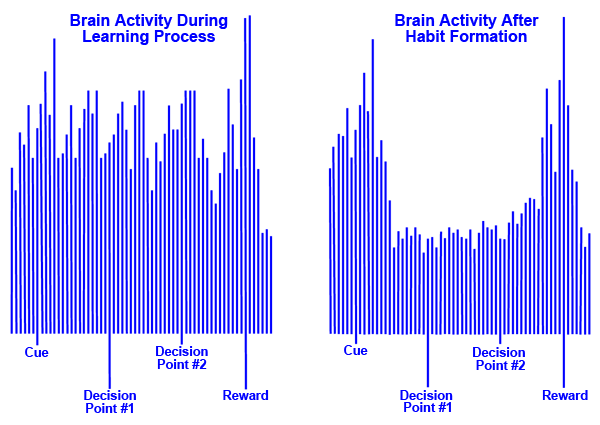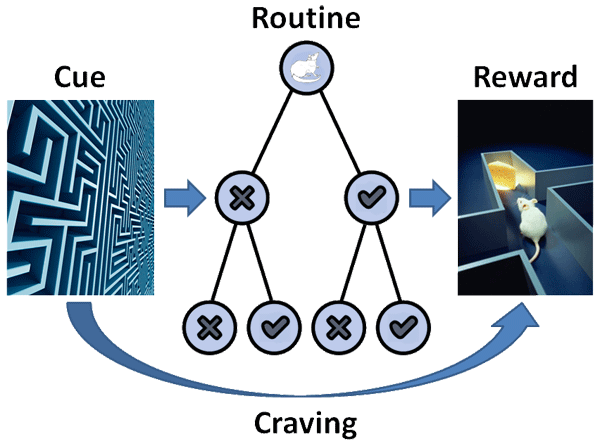Popular software programs provide a feature that enables users to capture programming sequences that they use habitually. It saves time and improves accuracy on repetitive tasks.
As it turns out, our brains have a similar mechanism. It manages this function in our behalf automatically. In fact, a 2006 study by Duke University revealed that 40% of our daily activities take advantage of these stored sub-routines. Charles Duhigg explores this fascinating subject in his book in The Power of Habit: Why We Do What We Do in Life and Business.
The brain’s basal ganglia provide the means to capture and store patterns of behavior, a process referred to as “chunking.” When chunks combine to form habits, our brains can process other thoughts, or simply enjoy a quiet moment.
Other members of the animal kingdom form habits. In fact, they’ve helped researchers figure out how habits work.
For example, scientists measured brain activity in rats as they learned to navigate a maze in search of cheese. During the learning phase, brain activity remained high from the time they entered the maze (their behavioral “cues”) until they reached their rewards (cheese). Once they’d mastered the routine, brain patterns were only elevated when encountering the initial cue and when reaping the fruits – or should I say, cheese – of their labors.
Of course, we don’t lock in on every pattern of behavior in which we’ve engaged. The reward must be sufficiently compelling to fuel anticipation for it. Craving powers the habit loop.
Once we’ve learned a habit, it remains in our memory banks indefinitely… or, at least, a really, really long time. Unfortunately, our brains don’t discern between “good habits” and “bad habits.” Even when we work hard at bypassing the latter, “bad habits” can re-emerge at any time.
So how can we reset our wiring so that we don’t get tripped up by our “bad habits”?
First and foremost, we need to amp up our awareness so that we don’t get caught operating on autopilot. We need to identify our “cues” – that is, the triggers that cause us to launch our bad habit loops. We also need to get crystal clear on the rewards that fuel these loops.
For example, suppose I find that I consistently break away from my home office at 3 pm to watch a little TV and nosh on whatever happens to be readily available in the refrigerator. I’d ask myself: What’s really going on at 3 pm that triggers this behavior? Am I bored? Fatigued? Restless? Tapped out? What payoff am I getting from watching TV? Am I simply looking for a way to give my mind a break? Or do I really think that I’m getting some form of creative input by my daily dose of Netflix? Moreover: Am I really hungry, or am I simply finding another avenue to relieve boredom?
After getting a handle on the cues (triggers) and cravings for reward, it’s easier to think creatively about launching different routines. For example, if my 3 pm date with the TV and the refrigerator reflects a need to take and break and clear my mind, I could simply take a short walk with my dog when the urge strikes.
Duhigg describes the Golden Rule of Habit Change as follows: Keep an old cue, deliver an old reward, but insert a new routine. A “competing response” disrupts an old habit. However, a new routine can only replace the old one when it is accompanied by faith that it will work – that is, faith that things will get better, and faith in one’s coping mechanisms when facing temptation, discomfort, or suffering.
When substantive lifestyle changes are at stake, it’s helpful to identify and strengthen keystone habits. When these habits shift, they have the power to dislodge and remake other patterns. For example, the keystone habit of regular exercise tends to make people eat better, smoke less, improve sleep patterns, experience higher productivity, and feel less stress. It creates a structure in which other forwarding habits flourish while delivering a series of self-reinforcing “small wins.”
Within the realm of keystone habits, willpower reigns supreme. Strengthen willpower in one area of your life, and you reap benefits in others. The bad news: Willpower is a bit like a muscle that can get fatigued by excess use. The good news: It is aided and abetted by tactics that conserve its energy – e.g., removing temptations, drawing attention away from triggers, consistently focusing on the prize.
Finally, as social creatures, we’re often helped (or sabotaged) by the company we keep. We increase our odds of success by placing ourselves within communities that support and reinforce habits that we hope to manifest every day.

